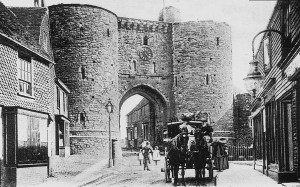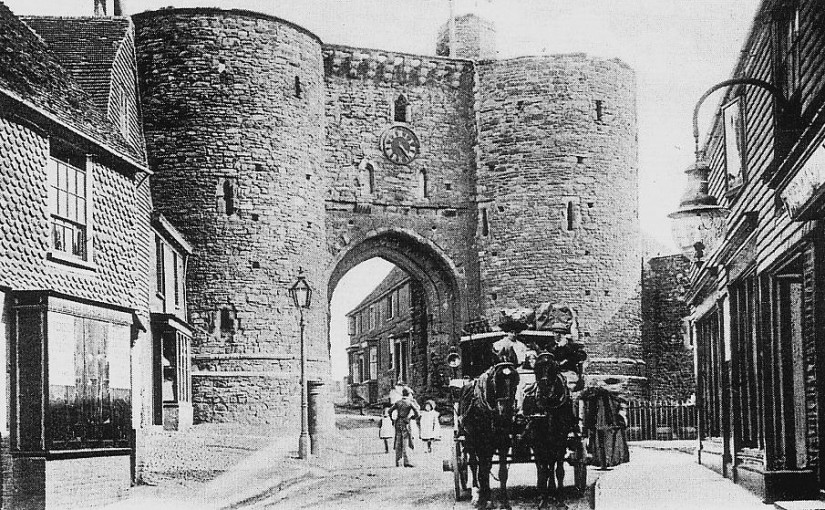By Arthur Woodgate Once again I am entering the world of fantasy mixed with a few points of fact. Basically my semi fable is centred round the junction of School Lane and Main Street, Peasmarsh, but unlike so many people today, I hope to move on through the main structure of my story to its completion.
About the one time industrial prosperous part of greater Rye, picture this large junction, if you can and bring your imagination along with me. We know that the large central area was at one time a pond and horse wash. The stream from which Stream Farm gets its name, ran down into it and then on and into a culvert under the farm track, that was where the A268 now is, and into the grounds of Stream Farm House; which was the home, no doubt of the landowner and farmer. the stream eventually ran into the Rother.
What of the other houses around the area? I believe that the wide pavement running corner-ways proves that building was once a mill and corn store, because the waggons bringing in the corn would need a wide pass by the pond to unload and to carry on through. It looks like a grist mill and the weather boarded house opposite at the bottom of School Lane was the home of the Miller.
It is known that close by was a tannery, so there had to be some cows and an abattoir if leather was the main object, so, as I think the saddler in King Street at Landgate would need some to make harness for the local farmers. I suspect that lots of small wild mammals would be processed as well. Not only fox skins for ladies to wear round their necks, but mole skins would have been needed by the thousands for hard working men to have mole skin trousers, so there must have been many skilled mole catchers to have kept the tanners going to supply the drapers. One use I have seen for mole skin trousers was when quick lime was being used on building sites.
It is my opinion that what we know as “Little Mead” and I first knew as “Crimea Cottage” was the home of the tanner, and next door “Vine Cottage” (now pulled down and rebuilt) was the stock-mans home and at the rear of these would have been an abattoir (not very big) with cows grazing in the rest of the field and still room for mole catchers. I knew “Crimea Cottage” for many years by that name. I also knew a man whose Grandfather came back from the War of that name and moved in and christened after that War. The manager of the tanyard would have been at least a non commissioned officer in the Army and would have brought home some of his private soldiers and found them jobs within the farm come tannery complex.

The two horse waggons would have gone up to the little oast which would have been on the corner of Orchard Way not only would the hops have been dealt with there but there were stables for several horses and there may have been more and the wagons would have had room to park. The man in charge of the hop growing and drying would have lived there.
It is my strong opinion that Stream Farm would have been a lot bigger and contained all the stream and not only joined Place House but could have lapped on to More Bread Farm. Being well known for Brambles and wonderful blackberries, which have given massive blackberry picking around Winders. As a wolf cub in the 1920s I used to walk up across the fields and go blackberrying and picnicking in that area, and beautiful blackberries they were too, and I imagine some would have been cultivated there for it could follow that other berries such as strawberries and raspberries would have been produced in great number. The building now known as the Horse and Cart would have been the home and office of the Bailiff (or if you prefer, Manager) and would have had round him the centre point of the crop collecting. So lets look at the people picking these crops and getting tired and thirsty. Their produce would have been brought to the centre which would be our now School Lane junction and dispatched to the markets and wholesalers. Likewise there would have been root crops such as swedes and even potatoes being brought back there by single horse dung carts. We would have seen storage piles of roots being built up around the area. What we see now as a car park for the pub would no doubt have been a grass paddock and park for the dung carts and trolleys. Although I believe only one horse drawn carts were worked from here there would have been more than one horse stabled here as there is room for more than one stable. Now with all this going on, I can hear the workers in the fields saying things like “I’ll be glad to get back where we can leave the horse and cart and get a drink”. But then his mate would say “But its a long way to the nearest pub” Hearing some of this talk going on, the farm foreman said “Don’t worry folks, I’ll buy in a couple of barrels of beer so you can come in and have a drink in my front room when you have put your “Horse and Cart” away for the night, and all you who have been working around it”. And so it came to pass that the conversation would be directed at getting back where they keep the “Horse and Cart”, and since this was where the single horses were kept, the name stuck. However, it was not a public house but could have been in time; looked on as a private beer house. In due course (I imagine when a new hard road was put through) a public licence was obtained, but only for six days a week, and this is how it was for some years. Later a seven day license was asked for and granted, so it became one of the most popular pubs in the area. The “Horse and Cart” will be around for many years to come.
“Rye’s Own” February 2008
All material and pictures on the Rye’s Own Website are subject to strict Worldwide copyright.
